Infectious laryngotracheitis (ILT) is a highly contagious respiratory disease of chickens and is responsible for significant economic losses in the poultry industry worldwide; it is caused by Gallid herpesvirus-1 (GaHV-1), commonly known as infectious laryngotracheitis virus (ILTV). In the United States the disease is controlled by vaccination with live attenuated vaccines, recombinant viral vector vaccines, or both (7). Experimental evaluation of ILTV strains is fundamental in order to identify changes in virulence that can contribute to the severity and spread of outbreaks and consequently influence the efficacy of vaccination. Under experimental conditions, different criteria had been utilized to measure virulence of ILTV isolates. These criteria included microscopic tracheal lesions, mortality, clinical signs (depression, respiratory distress, and conjunctivitis), weight gain, and trachea viral loads. Scoring the severity of clinical signs characteristic of ILTV infection has been mainly utilized to evaluate the degree of protection elicited by ILTV vaccination (1,2,11,14,21,22). Microscopic evaluation of trachea lesions was first utilized by Guy et al., (9), and they found that field isolates induced significant higher tracheal lesions than did vaccine strains. Kirkpatrick et al. (12) and Oldoni et al. (17) aimed to define the virulence of ILTV vaccines and outbreak-related isolates native to Australia and the United States, respectively. Although strains, infectious doses, and routes of inoculation were different in these two studies, they utilized clinical signs of the disease, microscopy tracheal lesions, and trachea viral loads as common criteria to evaluate ILTV strains virulence. Kirkpatrick et al. (12) concluded that microscopic tracheal lesion scores did not necessarily correlate with mortality but tracheal lesions did correlate with trachea viral load of Australian field strains. Oldoni et al. (17) found that, although significant differences existed in the duration and severity of disease caused by U.S. isolates, the severity of disease did not correlate with lesions detected in the trachea but rather with viral loads detected in the conjunctiva and sinuses. The reduced replication of U.S. strains in the trachea was associated to the route of administration, ocular–intra-nasal, rather than to the tropism of the viruses (17). Another parameter utilized to characterize the virulence of ILTV strains was weight gain. Kirkpatrick et al. (12) utilized weight gain as another parameter to characterize the virulence of ILTV strains and found that Australian field strains with high affinity for the conjunctiva severely affected the ability of birds to gain weight. The objective of this study was to compare the virulence of the standard United States Department of Agriculture (USDA) strain and the 63140 ILTV field isolate. The exact origin of the USDA standard strain is not known but it is believed it was isolated in the early 1960s. The USDA strain has routinely been utilized as the challenge virus in efficacy trials required for vaccine licensing. Strain 63140 is a virulent Georgia isolate, isolated in 2008 from a broiler outbreak. To attain the objective of this study, commercial broilers were inoculated intratracheally with increasing doses of each strain. The criteria utilized to evaluate virulence were clinical signs, mortality, microscopic tracheal lesions, tracheal genome viral loads, and antibody titers.
MATERIALS AND METHODS
Viruses
Two virulent strains of ILTV, the USDA challenge strain and the 63140/C/08/BR (63140), were propagated and titrated in chicken kidney (CK) cells from 3 to 4-wk-old specific-pathogen-free (SPF) chickens as previously described (19).
Experimental design
A total of 200, 1-day-old commercial broiler chickens were obtained from a local hatchery and placed in pens with water and feed provided ad libitum (Poultry Diagnostic and Research Center [PDRC], University of Georgia). At 21 days of age chickens were randomly distributed into 10 groups of 20 chickens each. Each group of 20 chickens was separated into two isolation units with filtered air and negative pressure. One unit housed 12 chickens and the second unit housed 8 chickens. Four groups of chickens were inoculated with the USDA challenge strain and four groups were inoculated with the 63140 strain. Both viruses were administered intratracheally (100 µl) at different doses. Four groups of chickens received either log 10 1.0, 2.0, 3.0, or 4.0 tissue culture infectious dose 50 (TCID50) doses of the USDA strain; another four groups of chickens received either log 10 1.0, 2.0, 3.0, or 4.0 TCID50 doses of the 63140 strain. The remaining two groups of chickens were inoculated with tissue culture media and kept as negative controls. Clinical signs were recorded from 12 chickens per group from days 3 to day 9 postinfection (PI). Tracheal swabs were collected at 3, 5, 7, and 9 days PI from 12 chickens per group. At days 5 and 9 PI, four chickens from each group were euthanatized and their tracheas removed for histologic examination. Blood samples were taken previous to inoculation and at 11 and 15 days PI to evaluate the antibodies induced by ILTV infection.
Mortality and clinical signs
Mortalities were recorded after monitoring twice a day from 1 to 15 days PI. Clinical signs of conjunctivitis, respiratory distress, and depression were scored as previously described by Vagnozzi et al. (21). Briefly, each clinical sign category was evaluated in individual chickens on a scale of 0–3; normal was given a score of 0, mild a score of 1, moderate a score of 2, and severe a score of 3. Total clinical signs scores (CSS) per chicken were obtained at 3, 5, 7, and 9 days PI, and the median clinical score per dose/per time point for each strain was calculated.
Microscopic examination of tracheal lesions
Tracheas were collected for microscopic evaluation from four chickens per treatment at days 5 and 9 PI. The lesions were scored from 0 to 5 as previously described (9). Briefly, microscopic scoring of tracheal lesions was performed as follows: Normal epithelium (score 0); mild to moderate lymphocyte infiltration (score 1); mucosa thickened by marked cell infiltration, few foci of syncytia with intranuclear inclusion bodies, or both (score 2); moderate to marked lymphocyte infiltration together with numerous syncytia with intranuclear inclusion bodies (score 3); normal epithelium absent, mucosal surface covered by a thin layer of basal cells, syncytia and intranuclear inclusion bodies occasionally present (score 4); no epithelium remaining and syncytia with intranuclear inclusion bodies rarely found (score 5). The median tracheal lesion scores per infectious dose at 5 and 9 days PI were calculated for each strain.
Tracheal virus loads
Total DNA was extracted from tracheal swabs collected at 3, 5, 7, and 9 days PI and processed for real-time PCR analysis as previously described (20). Briefly, the real-time PCR assay consisted of a duplex reaction where viral DNA was amplified with primers that targeted the region of the UL44 ILTV gene, and chicken DNA was amplified by primers that target the α2 collagen gene. The relative amount of viral DNA per sample was calculated as the log 10 of the 22ΔΔCt as previously described by Livak et al. (13).
Serology
Serum samples were collected from 6 chickens per group previous to infection and from 10 to 12 chickens at 11 and 15 days PI. Serum samples were analyzed for antibody titers against ILTV using the commercial ProFLOK® LT ELISA kit (Zoetis, Florham Park, NJ). The test was performed following the manufacturer’s recommendations.
Statistical analysis
Data were entered into a Microsoft Office ExcelH 2011 spreadsheet (Microsoft Corporation, Redmond, WA) and analyzed with Prism 6 (GraphPad, Software Inc., San Diego, CA). CSS among groups of chickens inoculated with infectious doses log 10 1 to 4 were compared at the peak of clinical signs for USDA or 63140 strains by a Kruskal-Wallis test (P< 0.05). CSS for groups of chickens inoculated with infectious doses log 10 1 to 4 of the USDA strain were compared separately to median CSS for the group of chickens inoculated with the same infectious dose of 63140 at 3, 5, 7, and 9 days PI using the Mann-Whitney test (P< 0.05). The trachea lesion scores obtained among groups of chickens inoculated with infectious doses log 10 1 to 4 of either USDA or 63140 were compared to the tracheal lesions obtained for the noninfected group of chickens at 5 and 9 days PI using the Mann-Whitney test (P< 0.05). The trachea lesion scores for groups of chickens inoculated with infectious doses log 10 1 to 4 of the USDA strain were compared to tracheal lesions scores obtained for the group of chickens inoculated with the same infectious dose of 63140 at 5 and 9 days PI using the Mann-Whitney test (P< 0.05). The trachea viral genome loads for groups of chickens inoculated with infectious doses log 10 1 to 4 of the USDA strain were compared to median trachea viral genome loads for the group of chickens inoculated with the same infectious dose of 63140 at 3, 5, 7, and 9 days PI using the MannWhitney test (P< 0.05). The ILTV serum antibody titers between groups of chickens inoculated with infectious doses log 10 1 to 4 of either USDA or 63140 were compared to titers obtained for the noninfected group of chickens at 11 and 15 days PI using the MannWhitney test (P< 0.05). The ILTV serum antibody titers for groups of chickens inoculated with infectious doses log 10 1 to 4 of the USDA strain were compared to antibody titers detected for the group of chickens inoculated with the same 63140 infectious dose at 11 and 15 days PI using the Mann-Whitney test (P< 0.05).
RESULTS
Mortality and CSS
No chickens needed to be culled during the experiment; mortalities recorded were chickens found dead after monitoring twice a day from 1 to 15 days PI. Percent mortality and the day postinoculation on which it occurred are presented in Fig. 1. All chickens inoculated with log 10 1 to 4 infectious doses of the USDA strain survived the infection. On the other hand, chickens inoculated with log 10 2 to 4 infectious doses of 63140 showed percent mortalities of 8% to 16%. One chicken was found dead at 5 days PI for the group of chickens that received log 10 4 infectious doses. At day 7 PI, three mortalities were recorded, one in the group of chickens that received log 10 2 infectious doses of 63140 and two in the group of chickens that received log 10 3 infectious doses. Chickens inoculated with log 10 1 infectious doses of 63140 did not present mortalities. Clinical signs were scored from days 3, 5, 7, and 9 PI for chickens infected with log 10 1, 2, 3, and 4 doses of the USDA and 63140 strains. Median CSS per day PI are presented in Fig. 2a and 2b for chickens inoculated with USDA or 63140 strain, respectively. Both strains respectively. Both of these strains presented similar trends in clinical signs levels over time. Chickens that received an infectious dose higher or equal to log 10 2.0 TCID50 of either strain showed an increase in CSS after three days PI, reaching the peak of clinical signs at 5 days PI and declining at 7 and 9 days PI (Fig. 2a,b). Chickens that received an infectious dose of log 10 1.0 TCID50 of either strain did not show a peak of clinical signs. CSS at 5 days PI increased significantly (P< 0.05) in groups of chickens inoculated with log 10 4 and 3 infectious doses, while groups of chickens that received log 10 2 and 1 infectious doses or either strain showed significantly lower (P< 0.05) CSS (Fig. 2a,b). The median CSS for groups of chickens inoculated with the same dose (log 10 1 to 4) of USDA and 63140 were compared at each time point (Table 1). As compared to CSS recorded for the USDA, significantly higher CSS (P< 0.05) were only observed by day 3 PI in groups of chickens that received a log 10 2 and log 10 4 infectious dose of 63140. No significant CSS differences (P<0.05) were observed between groups of chickens inoculated with the same infectious dose of USDA and 63140 at 5, 7, and 9 PI (Table 1).
Fig. 1. Percent mortality. Mortalities after inoculation with log 10 1 to 4 infectious doses of USDA and 63140 strains were recorded from day 1 to 12 PI. No mortalities were recorded in groups of chickens inoculated with log 10 1 to 4 infectious doses of the USDA strain or in chickens inoculated with a log 10 1 infectious dose of 63140. Percent mortality of chickens inoculated with log 10 2, 3, and 4 infectious doses of 63140 was 8.33%, 16.67%, and 8.33%, respectively
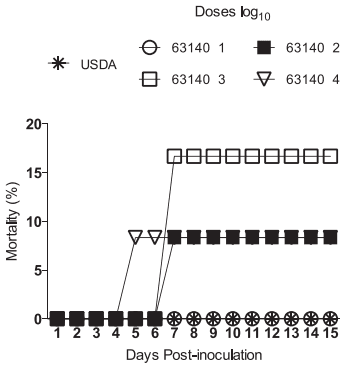
Fig. 2. Median CSS. (a) Median CSS for chickens inoculated with log 10 1 to 4 infectious doses of USDA strain. Significant differences, indicated with different superscript letters (Kruskal-Wallis test, P , 0.05), were observed in CSS at day 5 PI between log 10 4 and log 10 2; log 10 4 and log 10 1; and between log 10 3 and log 10 1 infectious doses of the USDA strain-inoculated groups of chickens. (b) Median CSS for chickens inoculated with log 10 1 to 4 infectious doses of 63140. Significant differences, indicated with different superscript letters (Kruskal-Wallis test, P , 0.05), were observed in CSS at day 5 PI between log 10 4, 3, and log 10 2; log 10 4, 3, and log 10 1; and between log 10 2 and log 10 1 infectious doses of 63140 strain-inoculated groups of chickens.
Microscopic examination of tracheal lesions
Tracheal lesion scores that resulted from histopathology examination of tracheas collected at 5 and 9 days postinoculation with the USDA and 63140 strains were first compared to trachea scores from noninfected chickens (Table 2). At 5 days PI, groups of chickens inoculated with infectious doses log 10 3 and 4 of USDA and 63140 strains showed median tracheal lesion scores of 4 to 5 that were significantly higher (P< 0.05) than scores in tracheas from noninfected chickens. Also at 5 days PI, the group of chickens inoculated with infectious doses log 10 2 of 63140 strain showed median tracheal lesion scores of 3.5, which was significantly higher (P< 0.05) than scores in tracheas from noninfected chickens
Table 1. Median (range) CSS from chickens inoculated with the USDA and 63140 strains at log 10 1 to 4 infectious doses.A
At 9 days PI, only the group of chickens inoculated with log 10 2 infectious doses of 63140 showed a median tracheal lesion score of 3.0, which was significantly higher (P , 0.05) than scores recorded for the noninfected group of chickens (Table 2). Tracheal lesion scores for groups of chickens inoculated with the same dose (log 10 1 to 4) of USDA and 63140 were compared at each time point. No significant differences were observed in tracheal lesion scores between group of chickens inoculated with the same infectious dose of USDA and 63140 at either 5 or 9 days PI (Table 2).
Table 2. Median (range) trachea lesion scores from chickens inoculated with log 10 1 to 4 infectious doses of the USDA and 63140 strains.
Tracheal viral genome loads
Median trachea viral genome loads and number of ILTV-positive samples detected at days 3, 5, 7, and 9 PI in chickens infected with log 10 1, 2, 3, and 4 doses of the USDA and the 63140 strains are presented in Table 3. Based on viral genome loads detected in trachea, the peak of viral replication was at day 3 PI for groups of chickens that received log 10 2 to 4 infectious doses of USDA or 63140 strains; by 5 days PI both USDA and 63140 viral genome loads decreased slightly in the trachea. Genome viral loads in trachea for groups of chickens that received the lowest infectious dose of USDA and 63140 peaked at 5 days PI. By days 7 and 9 PI, an abrupt decrease of the USDA genome loads was detected while the 63140 strain genomes in trachea were upheld to significantly higher levels (Table 3). The median trachea viral genome loads at each time point PI (3, 5, 7, and 9 days) for groups of chickens infected with the same infectious dose (log 10 1 to 4) of USDA or 63140 strains were compared (Table 3). At day 3 PI, chickens that received log 10 2 and 3 infectious doses of 63140 had significantly higher viral genome loads than did chickens that received similar infectious doses of the USDA strain. At day 5 PI, no significant differences (P<0.05) in genome viral loads were found between groups of chickens inoculated with the same infectious dose of USDA and 63140 strains. This was true for each of the infectious doses administered. However, at days 7 and 9 PI, trachea viral genome loads for chickens inoculated with log 10 1 to 4 infectious doses of 63140 were significantly higher than those detected in chickens inoculated with similar doses of the USDA strain. In particular, chickens inoculated with infectious doses of log 10 1 to 3 of 63140 showed significantly higher (P , 0.0001 to P , 0.0007) genome viral loads than did the USDA-inoculated chickens (Table 3). The percentage of ILTV genome-positive samples detected within each group of chickens inoculated with USDA or 63140 (log 10 1 to 4 doses) from day 3 to 9 PI are presented in Table 3. At days 3 and 5 PI, 91.7% to 100% of the tracheas collected from chickens that received a log 10 2 to 4 infectious doses of USDA or 63140 were positive for viral genomes. At days 7 and 9 PI, 58.3% to 91.6% of the tracheas collected from chickens that received a log 10 1 to 4 infectious doses of the USDA strain were positive for ILTV viral genomes while 81.8% to 100% of the tracheas from chickens that received a log 10 1 to 4 infectious doses of the 63140 strain remained positive for ILTV viral genomes.
Antibody titers
The group of noninoculated chickens showed negative serology while the USDA and 63140-inoculated groups of chickens showed positive serology, as indicated by the median ILTV antibody titers per group of chickens at 11 and 15 days PI (Table 4). No significant differences (P<0.05) in antibody titers were observed between groups of chickens that received the same infectious dose of USDA and 63140 at either 11 or 15 days PI.
DISCUSSION
ILT is a widely distributed respiratory disease of chickens which is usually preventable by means of biosecurity and vaccination. Despite extensive vaccination with live attenuated and recombinant viral vector vaccines, the disease causes significant economic losses in areas of intense broiler production. Experimental evaluation of ILTV circulating strains is fundamental in order to identify changes in virulence that can contribute to the severity and spread of outbreaks and consequently influence the efficacy of vaccination. Molecular epidemiology analysis revealed that genotype V is the most-prevalent virus circulating and causing outbreaks of the diseases in U.S. poultry (15,16). Isolate 63140/C/08/BR is a representative of genotype V viruses; its genome diverges in less than 40 nucleotides from the chicken embryo origin (CEO) vaccines (genotype IV) (8). The USDA standard challenge strain is the only identified virus within the genotype I group; its genome is most-closely related to the tissue culture origin (TCO) vaccine (8). The question this study attempts to answer is how these two genetically dissimilar strains differ in virulence. To identify differences in virulence, increasingly infectious doses of each strain were inoculated intratracheally to broiler chickens. The criteria utilized to evaluate virulence were mortality, clinical signs of the disease, microscopic tracheal lesions, trachea genome viral loads, and antibody titers. In a previous study (17), wide differences in severity and duration of clinical signs were observed among contemporary U.S. isolates and the CEO vaccine strain. However, virulence of the standard USDA challenge strain and a more-current strain of ILTV has not been evaluated before. In this study, clinical signs produced by the USDA and the 63140 strain were evident at 3 days PI, and significantly higher CSS were observed for chickens inoculated with log 10 2 and 4 infectious doses of the 63140 strain. The peak of clinical signs was observed at 5 days PI followed by a steady decline by 7 and 9 days PI. This trend was more marked at higher infectious doses. However, no differences in duration and severity of conjunctivitis, respiratory distress, or depression were observed between strains at any of the infectious doses at 5, 7, and 9 days PI. In contrast to clinical signs, four mortalities were recorded for chickens inoculated with log 10 2, 3, and 4 infectious doses of the 63140 while no mortalities were recorded for chickens inoculated with the USDA strain. The increased chicken mortalities caused by 63140 as compared to the lack of mortalities produced by USDA provided initial evidence of differences in virulence between these two ILTV strains. In contrast, tracheal lesion scores showed no differences between groups of chickens inoculated with the same infectious dose of USDA and 63140 strains. This result is in agreement with a previous study where microscopic tracheal lesions did not necessarily correlate with mortality but rather correlated with viral genomes loads (12).
Table 3. Median viral genome loads (log 10 22ΔΔCT) comparisons in tracheas from chickens inoculated with log 10 1 to 4 infectious doses of ILTV USDA and 63140 strains.A

Quantitation of viral loads in the trachea provided strong evidence that USDA and 63140 strains have different levels of virulence. At 5 days PI during the peak of clinical signs, independently of the dose, both viral strains replicated to the same levels, as no significant differences in genome viral loads were found between groups of chickens infected with USDA or 63140 strains. In contrast, by 7 and 9 days PI the replication of the 63140 in trachea was significantly higher than that of the USDA strain. The differences in 63140 and USDA genome loads detected in the trachea at late stages of lytic replication suggests that the USDA strain can be effectively limited by the host immune system, while the prolonged replication of the 63140 in the trachea suggests that this strain is possibly more effective at circumventing the host immune responses. Reddy et al. (18) found that a virulent Belgian ILTV strain blocks apoptosis of infected cells in the trachea and conjunctiva while inducing apoptosis in uninfected neighboring cells. They speculated that this mechanism might protect infected cells against clearance by the immune system, allowing infected epithelial cells to survive long enough to support replication and enhance mucosal invasion. It will be of great interest to compare the apoptotic and antiapoptotic capabilities of these two strains in trachea and conjunctiva. Higher viral loads in trachea of 63140-infected chickens at 7 and 9 days PI also suggests that 63140 has a more-prolonged shedding period than does USDA during the lytic infection. A transmission study is warranted in order to determine the degree of shedding of these two strains.
In this study, circulating antibody titers for chickens that received the higher virus infectious doses (log 10 3 and 4) were numerically higher, but statistically not different, than antibody levels detected in chickens that received lower infectious doses (log 10 1 and 2) of either USDA or 63140. However, no differences were observed among groups of chickens that received the same dose of either USDA or 63140, indicating that despite discrepancies in replication, both strains elicited the same level of circulating antibodies. Although the exact nature of ILTV protective immunity is not known, early studies proved that ILTV antibody responses do not correlate with protection while cell-mediated immune responses are essential to develop resistance to ILTV infection (4,5,6,10). Current research has shown that ILTV is capable of modulating the host immune responses, favoring the antibody-mediated responses over the cell-mediated responses in order to create conditions that favor viral survival (3). Therefore, it was not surprising to find that comparable levels of antibodies were elicited by both strains.
Table 4. Median ILTV antibody titers from groups of chickens inoculated with log 10 1 to 4 infectious doses of the USDA and 63140 strains.
Overall, scoring of clinical signs was a useful parameter to define the peak of clinical disease but, together with tracheal lesion, these parameters did not reveal obvious differences in virulence between the USDA and 63140 strains. On the other hand, increased mortalities induced by 63140, and significantly higher trachea viral genome loads were strong indication of differences in virulence between these two strains. Quantitation of genome viral loads at early and late stages of lytic infection in chickens that received increasing infectious doses of each strain was key to identifying differences in virulence between these two strains. This study provides a framework and criteria to compare virulence of other ILTV strains.
This article was originally published in Avian Diseases, Sep 2015 : Vol. 59, Issue 3, pg(s) 394-399 doi: 10.1637/11075-033115-Reg.1
REFERENCES
- Coppo, M., J. Devlin, and A. Noormohammadi. Comparison of the replication and transmissibility of an infectious laryngotracheitis virus vaccine delivered via eye-drop or drinking-water. Avian Pathol. 41:99–106. 2012.
- Devlin, J. M., G. F. Browning, J. R. Gilkerson, S. P. Fenton, and C. A. Hartley. Comparison of the safety and protective efficacy of vaccination with glycoprotein-G-deficient infectious laryngotracheitis virus delivered via eyedrop, drinking water or aerosol. Avian Pathol. 37:83–88. 2008.
- Devlin, J. M., A. Viejo-Borbolla, G. F. Browning, A. H. Noormohammadi, J. R. Gilkerson, A. Alcami, and C. A. Hartley. 2010. Evaluation of immunological responses to a glycoprotein G deficient candidate vaccine strain of infectious laryngotracheitis virus. Vaccine 28:1325–1332. 2010.
- Fahey, K. J., T. J. Bagust, and J. J. York. Laryngotracheitis herpesvirus infection in the chicken: the role of humoral antibody in immunity to a graded challenge infection. Avian Pathol. 12:505–514. 1983.
- Fahey, K. J., and J. J. York. The role of mucosal antibody in immunity to infectious laryngotracheitis virus in chickens. J. Gen. Virol. 71:2401–2405. 1990.
- Fahey, K. J., J. J. York, and T. J. Bagust. Laryngotracheitis herpesvirus infection in the chicken. II. The adaptive transfer of resistance with immune spleen cells. Avian Pathol. 13:265–275. 1984.
- Garci´a, M., S. Spatz, and J. Guy. Chapter 5. Infectious laryngotracheitis. In: Diseases in poultry, 13th ed. D. E. Swayne, J. R. Glisson, L. R. McDougald, V. Nair, L. Nolan, and D. L. Suarez, eds. Wiley-Blackwell, Hoboken, NJ. pp. 161–179. 2013.
- Garci´a, M., J. Volkening, S. M. Riblet, and S. Spatz. Genomic sequence analysis of the United States infectious laryngotracheitis vaccine strains chicken embryo origin (CEO) and tissue culture origin (TCO). Virology 440:64–74. 2013.
- Guy, J. S., H. Barnes, and M. Morgan. Virulence of infectious laryngotracheitis viruses: comparison of modified-live vaccine viruses and North Carolina field isolates. Avian Dis. 34:106–113. 1990.
- Honda, T., H. Okamura, A. Taneno, S. Yamada, and E. Takahashi. The role of cell-mediated immunity in chickens inoculated with the cellassociated vaccine of attenuated infectious laryngotracheitis virus. J. Vet. Med. Sci. 56:1051–1055. 1994.
- Johnson, D., A. Vagnozzi, F. Dorea, S. Riblet, G. Zavala, and M. Garcia. Evaluation of the protection induced by infectious laryngotracheitis virus vectored recombinant vaccines delivered in ovo. Avian Dis. 54:1251–1259. 2010.
- Kirkpatrick, N. C., A. Mahmoudian, C. A. Colson, J. M. Devlin, and A. H. Noormohammadi. Relationship between mortality, clinical signs and tracheal pathology in infectious laryngotracheitis. Avian Pathol. 35:449–453. 2006.
- Livak, K., and T. Schmittgen. Analysis of relative gene expression data using real-time quantitative PCR and the 22DDCt method. Methods 25:402–408. 2001.
- Mashchenko, A., S. M. Riblet, G. Zavala, and M. Garci´a. In ovo vaccination of commercial broilers with a glycoprotein J gene-deleted strain of infectious laryngotracheitis virus (ILTV). Avian Dis. 57:523–531. 2013.
- Oldoni, I., and M. Garci´a. Characterization of infectious laryngotracheitis virus isolates from the US by polymerase chain reaction and restriction fragment length polymorphism of multiple genome regions. Avian Pathol. 36:167–176. 2007.
- Oldoni, I., A. Rodriguez-Avila, S. M. Riblet, and M. Garci´a. Characterization of infectious laryngotracheitis virus (ILTV) isolates from commercial poultry by polymerase chain reaction and restriction fragment length polymorphism (PCR-RFLP). Avian Dis. 52:59–63. 2008.
- Oldoni, I., A. Rodri´guez-Avila, S. Riblet, G. Zavala, and M. Garci´a. Pathogenicity and growth characteristics of selected infectious laryngotracheitis virus strains from the United States. Avian Pathol. 38:47–53. 2009.
- Reddy, V. R., L. Steukersa, Y. Li, W. Fuchs, A. Vanderplasschenc, and H. J. Nauwyncka. The replication characteristics of infectious laryngotracheitis virus (ILTV) in the respiratory and conjunctival mucosa. Avian Pathol. 43:450–457. 2014.
- Rodriguez-Avila, A., I. Oldoni, S. Riblet, and M. Garcia. Evaluation of the protection elicited by direct and indirect exposure to live attenuated infectious laryngotracheitis virus vaccines against a recent challenge strain from the United States. Avian Pathol. 37:287–292. 2008.
- Vagnozzi, A., S. Riblet, G. Zavala, and M. Garci´a. Optimization of a duplex real-time PCR method for relative quantitation of infectious laryngotracheitis virus (ILTV). Avian Dis. 56:406–410. 2012.
- Vagnozzi, A., G. Zavala, S. Riblet, A. Mundt, and M. Garci´a. Protection induced by commercially available live-attenuated and recombinant viral vector vaccines against infectious laryngotracheitis virus in broiler chickens. Avian Pathol. 41:21–31. 2012.
- Zhao, W., S. Spatz, Z. Zhang, G. Wen, M. Garci´a, L. Zsak, and Q. Yu. Newcastle disease virus (NDV) recombinants expressing infectious laryngotracheitis virus (ILTV) gB and gD glycoproteins protect chickens against ILTV and NDV challenge. J. Virol. 85:8397–8406. 2014.

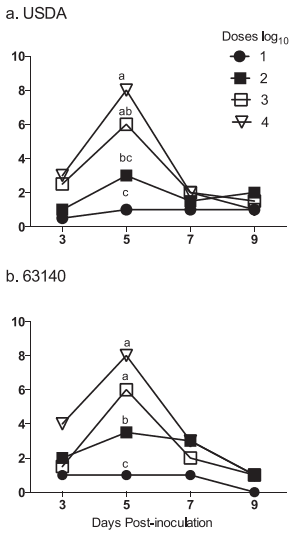
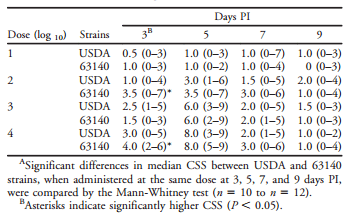
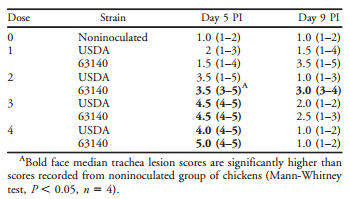

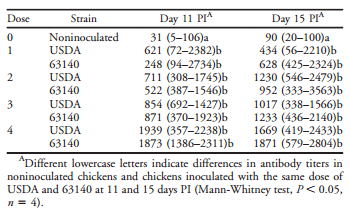









.jpg&w=3840&q=75)